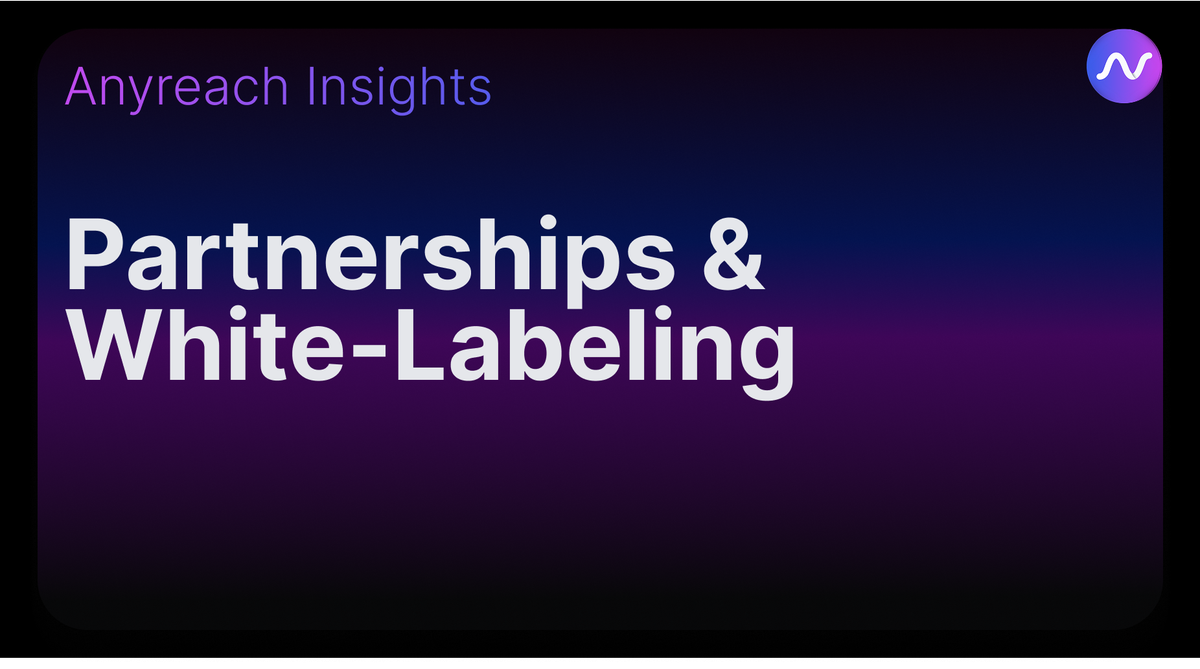Strategic AI Partnerships: How White-Label Solutions Transform Enterprise GTM

Enterprise adoption of agentic AI through partnerships and white-label solutions has emerged as a critical differentiator in 2024-2025. Organizations leveraging these collaborative models achieve up to 85% faster deployment and 30% lower operational costs compared to proprietary builds. This comprehensive guide explores how strategic partnerships and white-label solutions enable enterprises to accelerate their go-to-market strategies while maintaining competitive advantages.
What are partnerships in agentic AI?
Partnerships in agentic AI are collaborative relationships between AI technology providers and enterprises, resellers, or service providers that enable accelerated deployment and market penetration. These partnerships typically involve shared resources, technology access, and strategic alignment to deliver AI-powered solutions more effectively than standalone approaches.
The partnership landscape in agentic AI has evolved significantly beyond traditional vendor-client relationships. Modern AI partnerships encompass multiple models including direct sales collaborations, reseller networks, technology alliances, and white-label arrangements. According to McKinsey & Company, enterprises with robust partner ecosystems achieve 3x faster market penetration and 40% greater customer lifetime value compared to those relying solely on internal capabilities.
Key characteristics of successful agentic AI partnerships include:
- Shared Innovation: Partners collaborate on developing industry-specific solutions and use cases
- Resource Optimization: Pooled expertise reduces development costs and accelerates time-to-market
- Risk Distribution: Shared investment models minimize individual partner exposure
- Market Expansion: Access to partner networks enables rapid geographic and vertical penetration
- Continuous Evolution: Ongoing collaboration ensures solutions remain cutting-edge
What is white-label AI for enterprises?
White-label AI for enterprises refers to customizable, rebrandable AI solutions that organizations can deploy under their own brand identity. These solutions enable companies to offer sophisticated AI capabilities without developing proprietary technology, reducing time-to-market by up to 85% while maintaining full control over customer relationships and brand experience.
The white-label model has become particularly attractive for BPOs and service-oriented companies seeking to transform their service offerings. Rather than investing millions in proprietary AI development, enterprises can leverage pre-built, enterprise-grade AI platforms that offer:
| White-Label Feature | Enterprise Benefit | Typical Impact |
|---|---|---|
| Custom Branding | Maintains brand consistency | 100% brand control |
| Multi-tenant Architecture | Serves multiple clients efficiently | 70% infrastructure savings |
| API Integration | Seamless system connectivity | 90% faster deployment |
| Compliance Frameworks | Industry-specific certifications | 50% reduced compliance costs |
| Scalable Infrastructure | Grows with business needs | Unlimited scaling potential |
Industry research from Deloitte indicates that enterprises utilizing white-label AI solutions report average annual cost savings of $300,000 while achieving 2x improvement in sales close rates. This combination of cost efficiency and revenue growth makes white-label solutions particularly compelling for mid-market companies seeking enterprise-grade capabilities.
How does white-label AI support BPO partners in achieving competitive advantages?
White-label AI empowers BPO partners to differentiate their services through advanced automation, personalization, and efficiency gains. BPOs leveraging white-label solutions report 40-60% revenue increases per client and 50% operational efficiency improvements, transforming from cost-focused service providers to value-driven innovation partners.
The transformation enabled by white-label AI extends across multiple dimensions of BPO operations:
Operational Excellence
BPOs implementing white-label AI achieve remarkable operational improvements through intelligent automation. Case studies from leading BPOs demonstrate:
- Response Time Reduction: 75% faster query resolution through AI-powered routing and responses
- Quality Consistency: 90% reduction in quality variance across agents and shifts
- Capacity Scaling: Ability to handle 3x volume without proportional headcount increases
- Multilingual Support: Instant expansion to 50+ languages without specialized hiring
Strategic Value Creation
Beyond operational metrics, white-label AI enables BPOs to reposition themselves in the value chain. According to research from IBM, BPOs utilizing AI-powered solutions transition from transactional relationships to strategic partnerships, with documented cases showing:
- 250% increase in average contract values
- 5-year retention rates improving from 40% to 85%
- Expansion from single-service to multi-service engagements in 70% of accounts
Competitive Differentiation
White-label AI provides BPOs with unique competitive advantages that traditional service models cannot match. Key differentiators include:
- Rapid Innovation Cycles: Access to continuous AI improvements without internal R&D investment
- Industry Specialization: Ability to customize solutions for specific verticals while maintaining core platform benefits
- Data-Driven Insights: Advanced analytics capabilities that provide clients with actionable business intelligence
- Compliance Readiness: Pre-built frameworks for HIPAA, GDPR, and industry-specific regulations
What GTM strategy benefits arise from hybrid models in reseller partnerships?
Hybrid GTM models combining direct sales, reseller channels, and white-label partnerships deliver 3x faster market penetration and 40% higher customer lifetime value. These models enable strategic alignment across diverse market segments while maintaining flexibility to address specific customer needs through the most appropriate channel.
The sophistication of hybrid GTM strategies has evolved significantly as enterprises recognize the limitations of single-channel approaches. Leading organizations now orchestrate multiple channels in complementary ways:
Channel Synergy Framework
| Channel Type | Primary Focus | Ideal Use Cases | Success Metrics |
|---|---|---|---|
| Direct Sales | Strategic accounts | Complex, high-value deployments | Deal size, strategic value |
| Reseller Network | Market coverage | Regional/vertical expansion | Market penetration, volume |
| White-Label | Speed & customization | Industry-specific solutions | Time-to-market, satisfaction |
| Technology Alliance | Integration depth | Platform ecosystems | API adoption, joint solutions |
Strategic Benefits of Hybrid Models
Research from Gartner highlights several key advantages of hybrid GTM approaches:
- Market Resilience: Diversified channels reduce dependency on any single go-to-market motion, with McKinsey's model of 1,000+ partners demonstrating superior resilience during market disruptions
- Customer Choice: Different segments prefer different engagement models - enterprises value direct relationships while mid-market often prefers local partners
- Innovation Acceleration: Partners bring domain expertise that accelerates solution development for specific use cases
- Geographic Expansion: Local partners provide market knowledge and relationships that would take years to develop independently
Implementation Best Practices
Successful hybrid GTM strategies require careful orchestration and clear strategic alignment:
- Channel Conflict Resolution: Clear rules of engagement prevent partners from competing destructively
- Unified Enablement: Consistent training and support across all channels ensures quality delivery
- Performance Transparency: Shared metrics and dashboards align partner incentives with enterprise goals
- Technology Platform: Common technical foundation enables seamless handoffs between channels
How do enterprises ensure strategic alignment when working with multiple AI partners?
Enterprises ensure strategic alignment through governance frameworks, shared KPIs, regular business reviews, and integrated technology platforms. Successful multi-partner ecosystems require clear communication protocols, aligned incentives, and continuous collaboration to maintain focus on common business objectives while leveraging diverse partner capabilities.
The complexity of managing multiple AI partnerships has led to the emergence of sophisticated governance models. Leading enterprises implement comprehensive frameworks that address:
Governance Structure
- Executive Steering Committee: C-suite sponsorship ensures strategic alignment with business objectives
- Partner Advisory Board: Regular forums for collaborative planning and issue resolution
- Technical Architecture Review: Formalized processes prevent tool sprawl and technical debt
- Performance Management Office: Centralized tracking of partner performance against agreed metrics
Alignment Mechanisms
Successful enterprises employ multiple mechanisms to maintain strategic alignment:
- Shared Success Metrics: Partners are measured on business outcomes rather than just technical deliverables
- Integrated Roadmaps: Coordinated development plans ensure complementary rather than competing solutions
- Joint Innovation Labs: Collaborative environments for developing next-generation capabilities
- Cross-Partner Training: Regular knowledge sharing sessions build ecosystem cohesion
Risk Mitigation Strategies
Managing multiple partners introduces risks that require proactive mitigation:
| Risk Category | Mitigation Strategy | Implementation Approach |
|---|---|---|
| Data Security | Unified security framework | Common standards, regular audits |
| Integration Complexity | API standardization | Mandatory integration protocols |
| Vendor Lock-in | Multi-vendor strategy | Portable data, open standards |
| Quality Variance | Certification programs | Partner training, quality gates |
What role do channel partners play in agentic AI deployment?
Channel partners serve as critical bridges between AI technology providers and end customers, offering localized expertise, industry knowledge, and implementation support. They accelerate adoption by providing pre-sales consultation, customization services, training, and ongoing optimization, reducing deployment timelines by 60% while improving success rates.
The evolution of channel partners in the agentic AI ecosystem reflects a fundamental shift from traditional software distribution to value-added consulting and integration services. Modern channel partners provide:
Pre-Deployment Services
- Discovery and Assessment: Evaluating organizational readiness and identifying high-impact use cases
- Solution Architecture: Designing integrated solutions that align with existing technology stacks
- Business Case Development: Quantifying ROI and building executive buy-in
- Pilot Program Design: Structured approaches to prove value before full-scale deployment
Implementation Excellence
Channel partners bring specialized expertise that significantly improves deployment outcomes:
- Industry Specialization: Deep understanding of vertical-specific requirements and regulations
- Technical Integration: Expertise in connecting AI solutions with legacy systems
- Change Management: Proven methodologies for driving user adoption and cultural transformation
- Localization: Adapting solutions for regional languages, cultures, and business practices
Ongoing Value Creation
Beyond initial deployment, channel partners provide continuous value through:
- Performance Optimization: Regular tuning and enhancement based on usage patterns
- Capability Expansion: Identifying and implementing new use cases as organizations mature
- Training and Enablement: Ongoing education to maximize solution utilization
- Strategic Advisory: Guidance on emerging AI capabilities and industry best practices
Frequently Asked Questions
What timeline should enterprises expect for implementing white-label AI solutions?
Enterprises typically achieve initial deployment of white-label AI solutions within 30-60 days, compared to 12-18 months for custom development. Full-scale implementation including training and optimization generally completes within 90-120 days, with continuous improvements thereafter.
How do consumption-based pricing models work in AI partnerships?
Consumption-based pricing aligns costs with actual usage, typically charging based on metrics like API calls, processed transactions, or active users. This model reduces initial investment barriers and scales automatically with business growth, making it particularly attractive for mid-market companies.
What training and enablement resources do AI vendors typically provide to partners?
Leading AI vendors provide comprehensive partner enablement including technical certification programs, sales training, marketing collateral, demo environments, and dedicated partner support teams. Many also offer co-selling opportunities and joint go-to-market funding.
How can healthcare BPOs ensure HIPAA compliance with white-label AI?
Healthcare BPOs should select white-label AI providers with pre-built HIPAA compliance frameworks, including encryption, access controls, audit trails, and signed BAAs. Leading platforms offer compliance certifications and regular third-party audits to ensure ongoing adherence to regulations.
What are the key differences between exclusive and non-exclusive AI partnerships?
Exclusive partnerships offer dedicated resources and market protection but limit flexibility. Non-exclusive arrangements provide access to multiple solutions and reduce vendor dependency but may result in less partner investment. Most successful enterprises adopt hybrid approaches with strategic exclusivity in specific domains.
Conclusion
The strategic value of partnerships and white-label solutions in agentic AI deployment cannot be overstated. Organizations leveraging these collaborative models achieve demonstrable advantages in speed, cost, and market penetration while maintaining the flexibility to adapt to evolving business needs. As the AI landscape continues to mature, enterprises that build robust partner ecosystems and leverage white-label solutions will be best positioned to capitalize on emerging opportunities while managing risks effectively.
The evidence is clear: strategic alignment through partnerships, supported by white-label flexibility and hybrid GTM models, represents the optimal path for enterprises seeking to harness the transformative power of agentic AI. By embracing these collaborative approaches, organizations can accelerate their AI journey while building sustainable competitive advantages in an increasingly AI-driven business landscape.
]]>


![[AI Digest] Access Blocked Today](/content/images/size/w600/2025/07/Daily-AI-Digest.png)